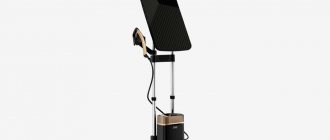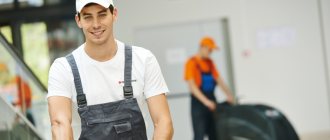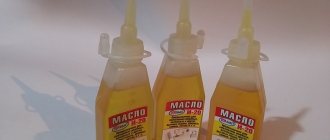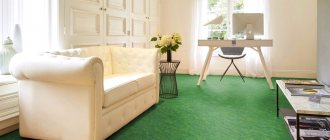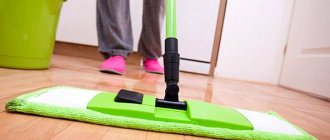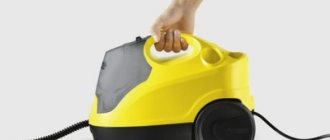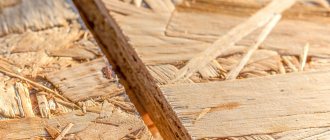When I was just starting to take my first steps in tailoring, my first sewing machine was my mother’s Soviet “Chaika”. If anyone was around this time, they probably remember these models. Their main difference from today's household sewing machines is that they operated using a foot pedal. It was at “Chaika” that I sewed my first dress, and from experience I can say that she sewed well, even now it is in working order.
Later I had to sew not only on household, but also on industrial equipment. I also sat down with various models of sewing machines from different manufacturers. And I have formed my own opinion on working with different equipment.
Unlike those times, today there is an abundance of choice of sewing equipment in stores for “dummies”. Today’s article will tell you how to choose a good sewing machine for beginners. In fact, this is the most popular question among my students, so get ready for the article to be very detailed.
Tip 2. A stitch that doesn’t tighten
The sewing machine should not make a stitch that would pull the fabric. This applies to delicate fabrics. When purchasing, be sure to make a few test stitches on pieces of fabric. Also see how the machine makes stitches on different fabrics:
- on the lungs - chiffon, silk, organza
- on medium and heavy - coat fabric, denim, linen, cotton, leather
- on elastic ones - knitwear, stretch.
Top 2. Leader VS 775E
Rating (2021): 4.85
A universal model that is used in everyday life and for a small number of private orders. Her arsenal includes overlock and blind stitches, elastic and decorative stitches, 8 types of automatic loops - in total, 99 operations are available to her. But the potential of the machine does not end there. A table to increase the working area allows you to work with bulky materials. For high-quality stitches and the convenience of craftswomen, there is a smooth speed adjustment, an automatic needle threader and a convenient informative display. A small fly in the ointment is a soft cover.
Characteristics:
24590 rub. / China / 99 operations
Tip 3. Even stitching
If you have the opportunity to test it in action before purchasing a sewing machine, I advise you to conduct a small experiment. Give the machine the opportunity to sew on its own without your help or participation. Place a piece of fabric under the foot and watch it make a straight stitch at a distance of the width of the foot from the edge of the fabric. To see better, take threads that contrast rather than match the fabric.
Using this experiment as an example, you will immediately see what the line turned out to be. Namely, does it go to one side, does it go at the same distance from the edge of the flap. If the stitching “leads” a little, then there is a defect in the assembly of the sewing machine and when you continue to use it, you will have to contact a repairman to adjust the teeth on the needle plate. In some cases, this defect cannot be corrected and in the future, with such a sewing machine, you will have to make efforts to ensure that the stitching is even.
Tip 4. Repairs and components
Look for a machine so that if it breaks down, you can repair it without problems. Spare parts and replacement parts should be sold in your city. Keep in mind that for expensive models all the components (foots, etc.) will also be expensive. Pay attention to the fastening of the foot. If it is unusual, check in advance where you can buy accessories for such a model.
If the model is unpopular or exclusive, then it may be a problem for you to replace the broken part. Otherwise, it will be taken out of production altogether, and the issue of repairs will never be resolved for you. Or the cost of repairs will cost the purchase of a new sewing machine.
Consult with sewing machine repair specialists in your city which machine will be easiest for them to repair. What models of sewing machines do they have experience with? For example, Janome, New Home - it’s much easier to hire them for repairs.
Professional's choice
In this block, we will tell you which sewing machine to choose for those who want to sew to order or have the best functionality for sewing and needlework. A machine of this class must have:
- electronic control;
- a wide range of operations, including various loops;
- reliability and comfort of work.
In this category, advanced features and reliability are directly related to the price of the machine. The low cost of an electronic machine means savings on the quality of components (plastic frame and parts instead of metal), a low-power motor, and minimal equipment.
Additional comfort is provided by electronic sewing speed control and a control panel with direct selection buttons, the ability to work without a pedal, precise needle positioning and automatic fastening. The top range models are equipped with a large, bright LCD monitor with an advisor program. The machine can have multi-point illumination of the entire work area (with brightness adjustment for expensive models) and automatic thread cutting with a button or by pressing a pedal.
Installing a knee lever for lifting the presser foot will free your hands for full control of sewing, and a large set of presser feet will allow you to quickly perform special operations.
The stores offer machines designed specifically for quilting or machine embroidery. They will open up new horizons for you in your favorite handicraft.
We recommend Brother NV F460
more details
| Shuttle | Peculiarity | Loops |
| Horizontal | Creating your own stitch | Automatic, 10 types |
Think twice before buying a machine that is 1.5-2 times cheaper than similar ones! The quality of the stitch is a relative concept and depends on many factors, including sewing ability.
Tip 6. Sleeve platform
In order to easily get to the most difficult places in clothes with a sewing machine, it must have a sleeve platform. How can I find out if it has such a device? To do this, you need to remove the compartment from the sewing machine, which is usually located under the needle plate. Now you can easily process the bottom of sleeves, trousers, as well as armholes and necklines.
Tip 7. Ruler on the needle plate
When purchasing, make sure that there is a ruler on the needle plate of the sewing machine, which will allow you to sew exactly the amount of allowance that you set when cutting. Example in the photo - I sew a stitch 1 cm away from the edge. The edge of the fabric on the right is located at the 1.0 mark. This device greatly simplifies the sewing process and speeds it up significantly!
Tip 8. Which sewing operations are really needed for work?
You must decide for yourself which sewing functions your machine should have - which you cannot do without. If you plan to sew simple things at home and do minor clothing repairs, then a machine with a basic set of functions :
- Straight stitch. You need to choose a sewing machine that makes a perfectly straight stitch.
- Zigzag stitch. It is needed for processing open sections of fabric to prevent it from fraying. Please note that the machine has the ability to adjust the width of the zigzag.
In addition to these two main stitches, you may also find useful sewing stitches such as:
Elastic zigzag for sewing elastic
Stretch stitch for knitwear
Reinforced straight stitch
Reinforced zigzag
Edge stitching, if you do not plan to pay for the machine - overlock
Invisible hem stitch
Stretch stitch for invisible hem
- Buttonhole processing function. With automatic mode, or semi-automatic - depends on your financial capabilities. You can make a quality loop in both modes.
- Reverse function (reverse). Necessary for making backtacks at the end of a stitch.
If you are not short of money, buy a sewing machine. Then you can consider additional functions in the machine that will also make your work easier:
- Regulator of presser foot pressure on fabric. It will come in handy when you sew fabrics of different thicknesses: chiffon or drape. There is a manual regulator - this is a disk or a screw, and an electronic one on computer machines.
- Spot tack. This will come in handy so you don't have to tie a knot every time you finish a stitch.
- Decorative stitches. Needed when placing various types of finishing stitches on clothes.
When purchasing, please note that the sewing machine includes the following parts:
- foot for sewing a regular zipper (single-arm)
- concealed zipper foot
- Teflon foot for working with leather
- roller hem foot
- assembly feet
- foot for sewing bias tape
- Needles
- Lubricating oil
Don't be upset if some components are missing. You can always buy the missing paws and needles. In addition, you may not need some additional details in your work.
Top 10 rating according to KP
Editor's Choice
Brother SM-340E
Brother SM-340E.
Photo: market.yandex.ru This model has 60 types of stitches. All of them are shown on the front panel directly below the display. And when you select the one you need, the image lights up on the screen. Schematic instructions and explanations are also provided on other parts of the device, which is convenient for beginners. It is even shown how to insert the thread into the needle and thread the bobbin. In the display area there are buttons that can be used to set the characteristics of the stitches. There is a needle threader, which, according to reviews, is convenient to use. Light nicks protrude along the edges of the model: they are needed to break the thread. On the lower platform there is a transparent window through which the bobbin can be seen. It is necessary to control the remaining threads.
The upper side part of the body is removed and becomes a container. By default, factory spare parts are stored there, but you can customize the container to suit your needs. It is possible to set the maximum speed: no matter how hard you press the pedal, you will not be able to accelerate beyond the setting. You can switch the automatic sewing mode: set the options, press and the home sewing machine does almost everything itself.
Characteristics:
| Control: | electronic |
| Shuttle: | horizontal |
| Number of operations: | 40 |
| A loop: | machine |
| Overcast stitch: | There is |
| Secret line: | There is |
| Elastic stitching: | There is |
| Elastic blind stitch: | There is |
| Sewing advisor: | There is |
| Display: | black and white |
| Stitch width: | up to 7 mm |
| Stitch length: | up to 5 mm |
| Platform: | sleeve |
Advantages and disadvantages:
Many operations
The needle breaks on thick fabric
show more
Singer 8280P
Singer 8280 P. Photo: market.yandex.ru
One of the best modern budget “zingers”. Suitable for beginners or for bulk purchases in sewing studios. It's quick and easy to understand due to the small number of bells and whistles. An important plus: the instructions are written very simply. The device itself is compact. You can wrap it in the complete cover and put it in the closet. It even takes thick neoprene. The main thing is to choose angles and threads.
The machine is also easy to maintain: once a month it is enough to drip a couple of milliliters of oil. The kit includes paws to sew on zippers or make buttonholes. One of the inconveniences is the lack of a thread threader, which can be critical for those who are impatient and sharp. Although these are rare in sewing. However, step-by-step instructions for threading are right on the body. You can detach the working surface to sew, for example, a sleeve.
Characteristics:
| Control: | electromechanical |
| Shuttle: | rocking |
| Number of operations: | 8 |
| A loop: | semi-automatic |
| Secret line: | There is |
| Elastic stitching: | There is |
| Elastic blind stitch: | There is |
| Stitch width: | up to 4 mm |
| Stitch length: | up to 5 mm |
| Platform: | sleeve |
Advantages and disadvantages
Easy to use
Not suitable for complex tasks
show more
Janome Exact Quilt 18A
Janome Exact Quilt 18A.
Photo: market.yandex.ru To select options for lines, stitches and operations on the front of the device there are three rotating switches. The thread fits into the eye of the needle without any problems. At the bottom of the case there is a hollow, removable part for storing small items. True, it is not particularly convenient. Seamstresses have access to 19 operations: different types of stitches from knitted to blind, overlock options, decorative.
The machine is made primarily of plastic. This has a positive effect on the weight - about five kilos, but some craftswomen consider the material unreliable. However, if you are going to sew a lot of coarse fabrics, like thick jeans, then this option will not work. There simply isn't enough power. User reviews about the model are diametrically opposed. The first, obviously not particularly demanding and whimsical buyers, who work with light fabrics, praise them. More experienced craftsmen, on the contrary, speak rather reservedly about the device.
Characteristics:
| Control: | electromechanical |
| Shuttle: | horizontal |
| Number of operations: | 19 |
| A loop: | semi-automatic |
| Overcast stitch: | There is |
| Secret line: | There is |
| Elastic stitching: | There is |
| Elastic blind stitch: | There is |
| Stitch width: | up to 5 mm |
| Stitch length: | up to 4 mm |
| Platform: | sleeve |
Advantages and disadvantages:
Lightweight
Not suitable for pros
show more
Tip 9. Which machine is better to choose: computer or electromechanical
If your sewing machine has a computer unit, but it makes ugly straight stitches, then of course this is a reason to think about it. In favor of electromechanical, but at the same time better quality in work. Therefore, before purchasing, be sure to check the product in operation: the stitching should not wobble, all stitches should be the same length and not pull the fabric when sewing.
If you choose a computer sewing machine, you will need to handle it very carefully. Do not use it continuously for a long time. For example, for industrial purposes, for an atelier. The computer unit has the unpleasant property of overheating and subsequently failing.
Tip 10. How to choose a sewing machine with an overlock function
The overlock function in sewing machines has appeared recently. This is a two-in-one model: a classic sewing machine and an overcasting machine. But don’t rush to rejoice if you decide to save money on buying an overlocker for your home. Because the “two-in-one” model only imitates an overlock stitch.
Externally, the stitch will look like an overlock stitch, but in terms of quality it clearly does not match the original. The strength is not the same. Essentially, a sewing machine with an overlock function is just a type of zigzag stitch.
Of course, two-in-one models will cost double the price. Is it worth paying extra for a separate stitch? If you sew for yourself and do not work for clients who care about the inside of their clothes, then a classic machine with a zigzag function will be enough for you.
Well, if you are a perfectionist and love a beautiful backside, it’s better to save up for a separate overlocker and don’t waste money on a sewing machine with an overlocker function.
Advice>>> How to save money on buying an overlocker? Buy an overcasting foot for a sewing machine. Or look at the tool compartment from your sewing machine; perhaps you already have one in your kit. It will create a zigzag seam more neatly than with a regular foot, especially when sewing delicate fabrics and knitwear. The edge will not curl or pinch as it usually does when overcasting. It also helps to produce high-quality finishing stitches, such as double parallel stitches on jeans. It is especially useful for beginners in sewing, when you are just learning how to make even stitches on fabric. Where can I buy a foot like this? I saw it on Aliexpress, and it is also available in sewing equipment stores.
⇡#Manufacturer
Here, as in any other field, there are market leaders and little-known companies.
The most famous are Minerva, Bernina, Janome, Pfaff, Brother, Singer, Husqvarna. The choice among leading manufacturers is largely determined by personal preferences, the availability in the store of a selection of the machines themselves and additional accessories for them. You should also take into account the availability of service centers in your place of residence - with a high mileage of the machine, this factor begins to play a significant role.
With less well-known companies, everything is not so clear. Often, with the same set of functions, a machine from an unknown company costs significantly less. But, in addition to the obvious risk of getting worse quality, here you may stumble upon another pitfall: difficulties in purchasing additional legs and components. Little-known companies often have very exotic foot mounts or bobbin sizes. Therefore, if you still decide to save money, be sure to find out which accessories are suitable for this model, and whether you will have the opportunity to purchase them without unnecessary hassle and overpayments.
Tip 11. What type of bobbin thread should you choose?
Which shuttle is preferable to choose, with horizontal or vertical filling? By making it possible to choose, sewing machine manufacturers have made the purchasing task more difficult for a beginner. The seller can tell you that you can take any, but there is still a difference, and now I will share with you exactly what it is. Machines with a horizontal shuttle are more functional, they have more lines used in work. And the vertical shuttle is more reliable, it breaks down and fails less often. In addition, you should proceed from your needs; if you plan to sew thick, heavy coat fabrics, then a vertical shuttle is best suited for these purposes.
Puncture force
What puncture force should beginners and professionals choose?
Modern machines are equipped with an electric motor that drives the mechanisms. Complex equipment has multiple levers, but is rarely installed at home. Budget models have an AC motor with a voltage of 220 W. This is enough for working with light and medium fabrics. Expensive devices have low-voltage DC motors. They can handle any materials.
Machines with electric motors have one criterion in common - the puncture force depends on the sewing speed. The device works with fabrics of any density if the specialist makes enough effort. To simplify the task, manufacturers began to install needle puncture force regulators. With it, the machine can sew both light and coarse fabrics, without forcing the master to try so much.
Beginners often pay attention to power, believing that the density of the fabric with which they can work depends on it. We will consider the importance of this factor for budget cars below. Expensive devices allow you to adjust the puncture force. In addition, manufacturers often write power that is several times higher than mechanical. Singer devices currently have the maximum value on the market.
The puncture force also depends on the sewing speed. For home use by beginners, models that allow you to smoothly limit this value are suitable. However, such machines are much more expensive. Some manufacturers, including Brother, offer foot pedal sewing. Judging by the reviews of professionals, they lack control. And beginners like to press a button and wait for the result.
Janome DC 603
The most reliable
A brand with an impeccable reputation, a large number of operations and a puncture force stabilizer that allows you to work with a variety of materials. This sewing machine is reliable and trouble-free. Rating participant:
20 best sewing machines
Tip 12. What is the difference between a household sewing machine and an industrial one?
These are two large groups into which all sewing equipment can be divided. The answer to the main difference between a household machine and an industrial one lies in the name itself. A household machine will not handle the amount of work and complexity that an industrial model can handle.
But an industrial machine performs only one operation. While the household one combines many functions: straight stitch, zigzag, loop processing mode. But at the same time, an industrial one will make hundreds of thousands of stitches per day and will not overheat. The durability and reliability of industrial machine parts is designed for decades of use.
A sewing machine for beginners should be chosen from the group of household machines. The reason for this is the high speed of industrial equipment. If you are just learning to sew, you may not be able to cope with a sewing machine that makes 5 thousand stitches per minute. The main danger for beginners when working with an industrial machine is injury. You can easily stitch your fingers.
In addition, an industrial machine will be too noisy for a home. Based on prices, household sewing machines are more budget-friendly and for beginners it is better to start learning to sew with them.
Loop processing mode
Which loop processing to choose
One of the additional parameters when choosing is the processing mode; without it, the product will not be finished. Modern sewing machines are capable of sewing buttonholes in semi-automatic and automatic modes. The latter is great for beginners practicing at home: just install the foot correctly and put a button in it. Then the craftswoman presses the lever, and the device does everything automatically. All that remains is to control the process.
Presser feet that can sew buttonholes automatically work without marking the fabric. They are guided by the button, which is fixed by the seamstress. On such machines there is a vertical lever that switches the movement of the device. It is located on the top and is used only for this operation.
Semi-automatic loops are not very different from their more modern counterpart, but require special knowledge from the master. The main difference is that the entire process needs to be controlled. The seamstress must manually turn on each of the 4 sequential operations and change modes in time. To do this, a handle is installed on the machines.
The standard process for semi-automatic buttonholes consists of several steps. The master sets the machine to the desired operation and lowers the presser foot. The first cycle can be started with any operation. But then the seamstress switches the device in time with the needle raised and changes the mode. The machine performs the operation in the opposite direction, the master stops the movement.
As can be seen from the example, in semi-automatic mode it is necessary to regularly switch the levers. Beginner seamstresses may find it inconvenient and will take longer to get used to. But for a professional, this function will be useful - the whole process is under control, you can always stop the device, adjust the fabric, or increase the distance.
Tip 13. Which brand of sewing machines to choose for beginners
Sometimes it happens that different manufacturers produce machines that are identical in quality and feature set. But these products can vary greatly in price. Therefore, in order not to overpay for the brand, choose sewing machines based on the price-quality ratio.
Pfaff, Husqvarna
- quite expensive models. If the car is exclusive, repairs will cost you a pretty penny.
Brother
— according to reviews, it has an uncontrollable pedal, makes poor-quality stitches
Janome
- the most optimal balance of “price - quality”. According to reviews from customers and my students, it has the highest ratings.
Astralux
— according to reviews, it is impossible to achieve high-quality stitching on thin fabrics with this machine. It also does not have a very high operating speed.
Sewing needles
How to choose a needle by point type
The main characteristic of needles is the point. First, the master determines this parameter, then considers the thickness. The standard tip is pointed and rounded, but the manufacturer offers dozens of additional options to choose from. We reviewed the most popular:
- Pointed. Suitable for most synthetic fabrics. There are 7 popular sizes - 60/8, 70/10, 80/12, 90/14, 100/16, 110/18, 120/20 - which are enough for all common materials. The first number indicates the diameter, the second the type of needle.
- Rounded. Most often used for jersey, suede, fleece and knitted fabrics. The tip pushes the fibers apart rather than sticking into them. This needle is included in the standard set and is in the home of every craftswoman.
- Stretch. So called because of the ability to stitch together materials containing lycra. It is used when working with underwear and swimwear. These needles have a small notch near the eye to prevent skipping stitches.
- For jeans. They are used not only for this material, but also for any dense fabrics. They are distinguished by their penetrating ability.
- For skin. The needle point is highly sharpened to penetrate products without damaging the material.
- For microfiber. Works best on dense, thin fabrics. Capable of creating a straight stitch and sewing off loops.
- For quilting. It has a long tip and a small eye to easily pass through several layers of material.
There are double and triple needles mounted on a nylon block, with wide ribs and slots in the eye. They are used for decorative stitches and complex techniques (embroidery at low speed for a short amount of time). Beginners and even experienced professionals usually do not need such needles.
Tip 14. Where to buy a sewing machine
Nowadays it is not a problem to buy a sewing machine. Now it is possible to compare products at prices in different stores. There are several ways to get yourself a home assistant.
Method 1. Internet. Many large hardware stores have websites; you can go to the website of such a company and view the offers of online stores. Don't worry that you won't be able to test the machine in action. Such stores have a warranty period during which you can return the sewing machine.
Method 2. Through specialized stores. In any large city there are shops selling sewing equipment. You can find them through the Double GIS application. In the field of activity column, type “sewing equipment” and organizations engaged in the sale of household (industrial) sewing machines will appear.
These stores employ specialists and craftsmen who can help you make the right choice based on your experience. They also give advice on working and caring for the machine.
Method 3. If you have a limited budget, then you can buy an inexpensive sewing machine on Avito. There you can buy a used sewing machine for half the price than in stores. To reduce the risk of buying a pig in a poke, take a person with you to the transaction who has experience working with sewing equipment.
Tip 15. Sewing machine price
A very common question among those who choose sewing machines is: Why are some models expensive, although machines from another brand with the same characteristics are half the price? Would it be better to make stitches with a machine that is more expensive? Here, first of all, you need to pay attention to the following points:
- Internal contents. Different manufacturers have different requirements regarding the quality of parts. Cheap appliances may be equipped with plastic parts, while a more expensive brand may have special quality control at the factory.
- Even if at first glance you have machines in front of you that have the same functions, they can do it in completely different ways. One manufacturer can seriously invest in developing models, speeding up the process, and using the latest developments in technology. And the other is to do everything the old fashioned way, which of course will affect the low cost.
- Advertising. It is no secret that some manufacturers invest their advertising and product packaging costs into the price of sewing machines. After all, in order for people to talk about her, you need to talk about her, right)
And finally, I can say with the famous proverb that a miser pays twice. This also applies to sewing equipment. If you plan to use your assistant every day for a long time, then it is better to take a high-quality one with good filling. Otherwise, you risk spending twice as much on repairs and components. Also plan to purchase from an authorized dealer with support, this means that you will not be abandoned in the event of a breakdown or with spare parts.
What sewing machine do I use now?
I have a Family machine on my desk. This is the most common inexpensive sewing machine with a minimal set of functions. From experience, I can say that I use only two lines on it - straight and buttonhole mode. No need for work anymore. Unless, of course, you make quilts or do patchwork. I have been sewing on it for ten years, and with proper care, such an assistant will last you just as long.
I also have another sewing machine - a carpet lock. I use it for overcasting the edges of clothes and when sewing knitwear.
Therefore, my main advice to you is that the simpler the sewing machine model, the more convenient it will be for you to understand it. In everyday life, for sewing at home, one sewing machine is enough, which makes a beautiful straight stitch.
Top 3. Singer Starlet 6680
Rating (2021): 4.70
A computerized machine with 80 sewing operations, the functionality of which allows you to sew diverse products and decorate them with dignity. 6 automatic loops, blind stitch, overcast, elastic, decorative seams. The puncture force stabilizer ensures high-quality sewing of both thin and coarse materials. For working with bulky items and for patchwork sewing, the set includes a table to expand the working platform. The set contains 6 feet, including feet for sewing in zippers, sewing buttonholes and sewing on buttons. Buyers like the potential of the machine and its equipment, but some have complaints about the quality of its assembly.
Characteristics:
17005 rub. / Vietnam / 80 operations
Online cutting and sewing courses for beginners video - lessons
If you have purchased a sewing machine and don’t know where to start, I have online cutting and sewing courses for beginners:
1) Design - this course is suitable for those who want to learn how to create patterns and take measurements of a figure. To successfully pass here you do not need to be an ace in drawing or have any special skills, the information is presented easily and simply
2) A basic course in cutting and sewing is the basics. I suggest taking it to all beginners who are in search of sewing knowledge and don’t know where to start. This course was pieced together from my offline (live) sewing courses, which I have been teaching in the city of Ufa since 2014. I know at what stage students may have difficulties, so I can help you
3) A course on sewing pajamas and underwear - this course was born in the process of working on master classes on home clothes, when I saw that my interest in it deserves separate training. In this course we sew using ready-made patterns, so it is perfect for complete beginners who are still afraid to delve into the processes of constructing patterns. Honestly, you can even take this course with your children, because it is interesting, and you can get results very quickly!

